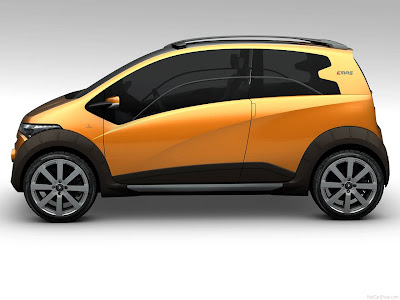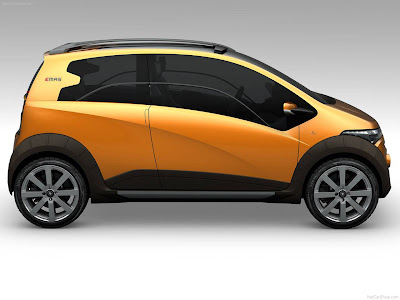




The Emas Country interpretation portrays the Emas as an urban SUV, keeping to the length of 3550 mm but switching to a three-door architecture.
Access to the car is still easy due to generous doors measuring no less than 1350 mm in length and the ergonomic and rational position of the rear seats, that are set 120 mm further forward than in the five-door version.
In particular, the amount of passenger room rises from 4 to 5 seats by replacing the two independent rear seats with a sliding three-seater bench seat. This means that the amount of foot room for passengers in the rear can be adjusted according to requirements.
The bench seat can also be folded completely flat to increase the load volume: this boosts the luggage space from 390 to approximately 780 litres.
A few telling touches create a distinctive off-road exterior look: wheel arches, side-sill perimeter base, bumpers toughened by radial ribbing and the lower part of the tailgate are highlighted by a bronze metallic finish. The roof features a rollbar/roof-rack.
The front-end differs from the urban, five-door version due to its more aggressive look: the Proton shield is now fitted at the top of a grille surmounting a large longitudinal air intake. The two fog lights are round and sunk into the body.
The lower part of the front and rear bumpers and the side-sills are toughened by metal inserts.
A glance at the interiors
The first aspect that strikes you, even before you discover the car interiors, is the door handle: an ergonomic design that incorporates a set of secondary controls that vary from place to place.
The driver can use the handle grip to control all four power windows, door locking and unlocking, the courtesy lights, side mirror adjustment and electrical lowering of the rear head restraint to improve visibility while reversing.
The front passenger can also adjust the hi-fi system as well as his or her own window. The rear passengers can also adjust their seats from the handle grip.
Two TFT panels dominate the dashboard. They are housed side by side in the centre of the dashboard, at a concave angle.
The right-hand monitor shows the speedometer and the main car operating indicators in addition to hybrid system energy flows.
The left-hand monitor shows secondary information such as screens for the hi-fi system, telephone and internet access browser plus personalised car set-up parameters.
A third display, located beneath the central console, is a touch screen that controls all the car's main and secondary functions. The right part of this TFT screen permanently displays the climate system temperature and air flows.
The lower part of the central console, housing the ignition button and gear selector, extends towards the tunnel and can be folded down. When parking in a tight spot, forcing the driver or front passenger to leave the car from the opposite side, this central element can be lowered and the seat moved back so that they can get out on the other side without hindrance.
The central console also houses two USB ports to connect digital music players and mobile phones, plus an SD card slot for satellite navigation maps.
The central part houses a dock specially designed for the Apple iPhone. This dock is interchangeable and can house other phone and smartphone models. It can recharge the phones and connect them automatically to the car without the need to use other coupling systems.
Powered by Lotus Engineering
The drive system is a series hybrid plug-in developed by Lotus Engineering, a Proton Group company. It includes a 3 cylinder 1.2 litre internal combustion engine developing 51 horsepower (38 kW) at 3500 rpm that can run on petrol, ethanol, or methanol.
The front transverse internal combustion engine is coupled to a generator and serves exclusively to recharge the 11.5 kWh capacity lithium ion batteries.
Drive is assured by an electric motor with continuous power of 45 kW and 75 kW peak power.
The high maximum torque, 240 Nm, does not require the use of a gearbox.
Acceleration 0-100 km/h takes place in 14 seconds, top speed is 170 km/h and battery range in the hybrid configuration is 50 km. Full recharging of the battery pack takes three hours using a traditional 240-volt outlet.
The performance and range of the City three door electric plug-in version are currently being assessed.
Access to the car is still easy due to generous doors measuring no less than 1350 mm in length and the ergonomic and rational position of the rear seats, that are set 120 mm further forward than in the five-door version.
In particular, the amount of passenger room rises from 4 to 5 seats by replacing the two independent rear seats with a sliding three-seater bench seat. This means that the amount of foot room for passengers in the rear can be adjusted according to requirements.
The bench seat can also be folded completely flat to increase the load volume: this boosts the luggage space from 390 to approximately 780 litres.
A few telling touches create a distinctive off-road exterior look: wheel arches, side-sill perimeter base, bumpers toughened by radial ribbing and the lower part of the tailgate are highlighted by a bronze metallic finish. The roof features a rollbar/roof-rack.
The front-end differs from the urban, five-door version due to its more aggressive look: the Proton shield is now fitted at the top of a grille surmounting a large longitudinal air intake. The two fog lights are round and sunk into the body.
The lower part of the front and rear bumpers and the side-sills are toughened by metal inserts.
A glance at the interiors
The first aspect that strikes you, even before you discover the car interiors, is the door handle: an ergonomic design that incorporates a set of secondary controls that vary from place to place.
The driver can use the handle grip to control all four power windows, door locking and unlocking, the courtesy lights, side mirror adjustment and electrical lowering of the rear head restraint to improve visibility while reversing.
The front passenger can also adjust the hi-fi system as well as his or her own window. The rear passengers can also adjust their seats from the handle grip.
Two TFT panels dominate the dashboard. They are housed side by side in the centre of the dashboard, at a concave angle.
The right-hand monitor shows the speedometer and the main car operating indicators in addition to hybrid system energy flows.
The left-hand monitor shows secondary information such as screens for the hi-fi system, telephone and internet access browser plus personalised car set-up parameters.
A third display, located beneath the central console, is a touch screen that controls all the car's main and secondary functions. The right part of this TFT screen permanently displays the climate system temperature and air flows.
The lower part of the central console, housing the ignition button and gear selector, extends towards the tunnel and can be folded down. When parking in a tight spot, forcing the driver or front passenger to leave the car from the opposite side, this central element can be lowered and the seat moved back so that they can get out on the other side without hindrance.
The central console also houses two USB ports to connect digital music players and mobile phones, plus an SD card slot for satellite navigation maps.
The central part houses a dock specially designed for the Apple iPhone. This dock is interchangeable and can house other phone and smartphone models. It can recharge the phones and connect them automatically to the car without the need to use other coupling systems.
Powered by Lotus Engineering
The drive system is a series hybrid plug-in developed by Lotus Engineering, a Proton Group company. It includes a 3 cylinder 1.2 litre internal combustion engine developing 51 horsepower (38 kW) at 3500 rpm that can run on petrol, ethanol, or methanol.
The front transverse internal combustion engine is coupled to a generator and serves exclusively to recharge the 11.5 kWh capacity lithium ion batteries.
Drive is assured by an electric motor with continuous power of 45 kW and 75 kW peak power.
The high maximum torque, 240 Nm, does not require the use of a gearbox.
Acceleration 0-100 km/h takes place in 14 seconds, top speed is 170 km/h and battery range in the hybrid configuration is 50 km. Full recharging of the battery pack takes three hours using a traditional 240-volt outlet.
The performance and range of the City three door electric plug-in version are currently being assessed.